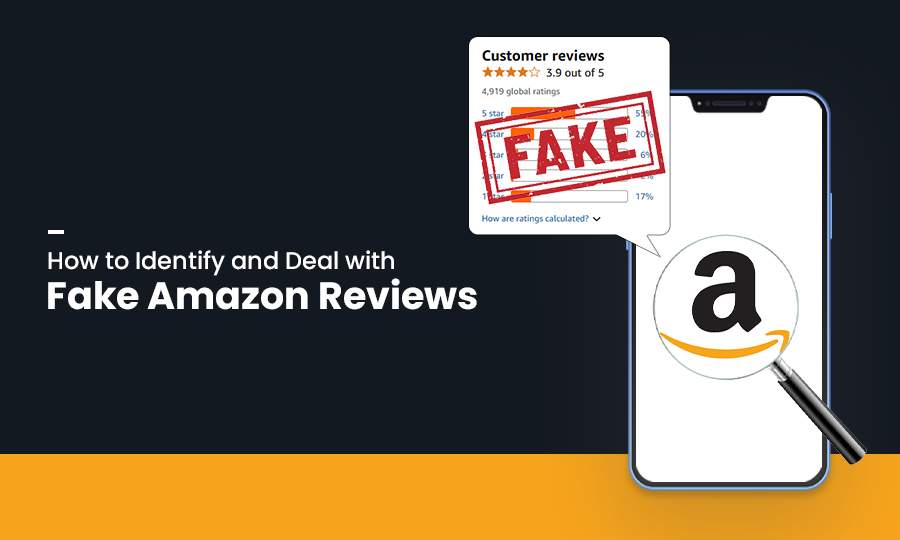Where do the majority of people end up searching when they want to buy something online? It’s Amazon – one of the leading online retailers in the US and the UK. This e-commerce platform is widely popular worldwide for its extensive product selection, competitive pricing, and user-friendly shopping experience. Most people make purchase decisions based on the customer reviews on Amazon. However, did you know that there are also many fake Amazon reviews?
As per a report, nearly 42% reviews on Amazon are fake. Yes, you heard that right!
The rise of fake reviews on platforms like Amazon has become extremely significant for various reasons, including increasing brand competition, the utilization of digital advancements such as AI bots, and fraudulent customers.
As a result, brands are facing challenges in attracting new customers, while consumers are losing trust in even the most reliable businesses. The only solution is – to learn to identify and effectively handle those fake reviews on Amazon. This guide will provide you with some proven strategies to detect and address fake reviews on Amazon.
What Are Fake Amazon Reviews?
These are fraudulent customer reviews, mostly shared with the intention to mislead shoppers about a product’s quality and performance. These reviews are mostly not genuine and truthful, but can have both positive and negative impacts on a product.
Sounds complex? Let’s understand it more easily.
You need to understand one thing that fake reviews are not necessarily negative. These can be positive as well, especially to boost a product’s ranking, while the negative fake reviews can severely affect a product’s reputation on Amazon.
The bad news here is – the existence of fake reviews on Amazon remains a persistent issue, even though Amazon invests a lump-sum amount in detecting and removing fake reviews.
How does Amazon rank products? The e-commerce site generally ranks products based on overall sales and customer feedback. However, honest sellers on Amazon risk losing potential customers, revenues, and credibility.
Because of these fraudulent reviews, honest sellers on Amazon lose
- Their potential customer
- Overall product sales and revenues
- Credibility
Additionally, Amazon’s review system, as well as the entire algorithm, loses its value. Review manipulation can skew search results and even the Best Seller badge. On the other hand, many brands engage in generating fake reviews to boost their products’ rankings on Amazon.
But do you know that it can trigger serious penalties, including Amazon listing suspension and even account ban, if caught?
Thus, effective review management strategies are crucial for brands, specifically to detect and handle fake reviews on Amazon before they harm your online reputation and product revenue.
5 Major Types of Fake Reviews on Amazon
Fraudulent Amazon reviews have different characteristics and ways to impact a product. Based on why people have shared those reviews and the nature of the reviews, we’ve divided fake reviews into five major types. Let’s have a look.
- Fake Positive Reviews – These reviews are written to boost a product’s ranking and manipulate sales on Amazon. Brands often engage in generating these fake positive reviews about their products to create a fake scenario that their products are being loved by the majority of customers. These are not at all related to the genuine customer experiences, mainly shared to create a ‘hype’ about a specific product.
- Fake Negative Reviews – Have a significant number of negative reviews started appearing suddenly on your product page on Amazon? It’s more likely that your industry competitors may be trying to sabotage your Amazon listing or harm your sales. These are considered fake negative reviews, mostly including fabricated claims and comparisons.
- Paid/Incentivize Reviews – Many times, brands that fail to drive more sales through their products try to buy positive reviews to boost their product’s rankings on Amazon. They often offer free products, discounts, and other rewards to people in exchange for positive reviews. Let us tell you that this is a complete violation of Amazon’s terms of service!
- Swapping Reviews – These reviews are something that can positively impact both you and your competitors. It’s the practice of exchanging positive reviews on Amazon between businesses. For example, you want to boost a specific product’s ranking on Amazon, and so as your competitor. So you both agree to review each other’s products on Amazon in return for a positive review itself.
- Bot-generated Reviews – Automated software, like Artificial Intelligence (AI), generates fake positive reviews mostly in generic and repetitive language. Brands often employ these review bots to improve the product ratings, increase their review counts, and create a false sense of popularity for those products.
How Can Fake Amazon Reviews Impact Your Brand Reputation?
According to a 2021 study by Amazon, nearly 77% of consumers read product reviews before buying anything on Amazon. People largely rely on reviews before they make purchase decisions.
It works just like a word-of-mouth recommendation from their friends and family!
And who doesn’t prefer to know about a product more before they actually purchase it?
Just the way a genuine review can influence a buyer to consider a product, fake Amazon reviews can erode potential customers’ trust and harm a brand’s reputation. Here’s how fake reviews on Amazon can impact your business’s reputation.
- Misleads Your Customers
If your product page on Amazon is filled with false positive or negative reviews, it is more likely to present a false positive or negative narrative of your products. For instance, the quality of a product is average, while the fake positive reviews tell a different story.
It will mislead customers in making informed purchasing decisions. Similarly, fake negative reviews can mislead people and prevent them from purchasing genuinely good products. Because of this, you, as a seller, may also suffer!
- Harms Honest Brands
Fake reviews on Amazon can create a sense of distrust among your potential customers. It makes it difficult for them to identify genuine reviews from fabricated feedback, which harms the sale of even the honest brands selling good products on Amazon.
Imagine someone has purchased an electronic product from a brand on Amazon, seeing the good reviews. But after using that product, he/she found that the product is not as good as those reviews. The customer is more likely to lose confidence in your brand and share their negative experience when they realize that those positive reviews are fake and have misled him/her.
- Wastes Time and Money
It potentially wastes the time a consumer spends searching for suitable products on Amazon and the money they invest in buying a product. Such fabricated reviews, either positive or negative, inflate product ratings and make consumers struggle to find genuine products on Amazon.
So the reviews mislead consumers who make purchase decisions based on false information. Customer disappointment, a loss of trust in your brand, wasted time and money of the customers – fraudulent Amazon reviews often result in these and even more.
- Encourages Low-quality Product Sales
For instance, a brand is selling poor quality products on Amazon but has bought paid fake reviews to boost their products’ rankings. It will naturally encourage their low-quality product sales!
But eventually, people will realize that those reviews are fake and the products don’t meet their expectations. The fake negative reviews have manipulated the perceived popularity and quality of those products. This can lead to the buyers’ dissatisfaction and a loss of trust in the brand and Amazon as well.
How to Spot Fake Amazon Reviews?
Yes, this is now a task!
Are you one of those who think every bad review is fake? If yes, then you’re highly MISTAKEN!
Sometimes, even the positive reviews can be bought, manipulated, or AI-generated to boost a brand’s product ranking on Amazon. And the negative reviews can be authentic based on a product’s actual poor quality. Thus, it’s a crucial task to differentiate fake reviews from genuine ones.
This requires specific strategies to spot fake reviews on Amazon, as there are many, more than you can ever imagine. Here we will talk about how you can detect fake reviews on Amazon like a pro.
Strategy 1: Identify Suspicious Review Patterns
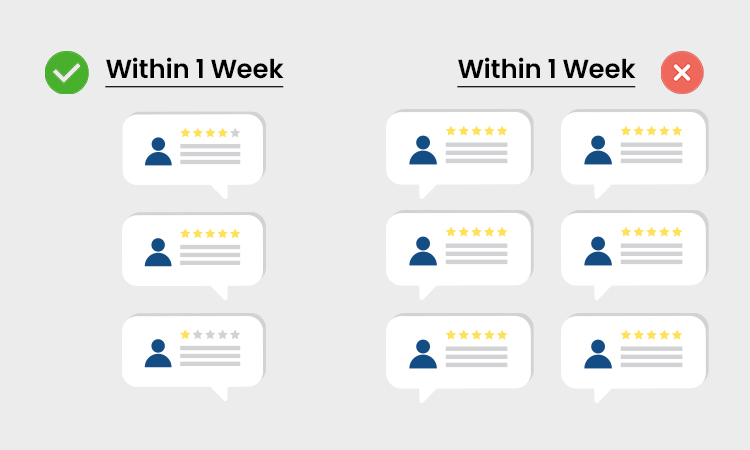
Have you ever come across a long list of positive reviews under a specific product page?
Those reviews may not necessarily be authentic. But how can you spot those fraudulent reviews? The answer is by identifying suspicious review patterns.
Fake reviews often have a unique pattern, and your job is to detect that. Once you spot that, you can identify fake reviews in no time. As a seller on Amazon, you must closely track your customer review trends. Below, we’ll talk about the major signs identifying which you can spot fake reviews on Amazon.
Top 10 Signs of a Fake Review on Amazon
The following are 10 key signs of a fake Amazon review. Let’s have a look!
- Have you witnessed a sudden increase in your Amazon reviews? If they’re all positive or negative, they can be fake!
- Sometimes, your product page on Amazon can be flooded with an unusual percentage of 5-star ratings. But those ratings can have critical reviews. Suspicious, right?
- If the majority of your customer reviews contain identical words, phrases, and generic praises, they can be fake.
- Some Amazon reviews often contain feedback regarding unrelated products or odd details. These reviews are more likely to be fake ones.
- Do your Amazon reviews contain only one word or extremely generic sentences (e.g., ‘Awesome product!’, ‘Bad quality!’, Terrible’, ‘Nice’)? If yes, then it’s time to check the authenticity of those reviews.
- Have you received too many reviews on the same date? It can be a sign of fake reviews.
- Fake reviewers often post feedback from the same profile. You need to check whether you receive many reviews from the same profile. Check if the reviewer profile has only a few reviews or only positive reviews for a specific brand on Amazon.
- If the reviewer doesn’t have a clear and identical profile picture and original information, the reviewer is more likely to be fake. Apart from this blank profile picture or suspicious details can be a sign of a fraudulent reviewer.
- Amazon reviews that talk about extremely positive or negative aspects of a product can be fake. These reviews often lack specific reasons for sharing those reviews.
- If the reviewer’s profile doesn’t have a verified purchase tag, you must track the reviewer’s profile activity.
Note: Amazon offers a Verified Purchase tag for reviewers who share feedback about a product that he/she purchased. It will let you know that the review is genuine. But here is a loophole as well! Some sellers on Amazon refund purchases to enable reviewers to get this badge and share a fake review.
Strategy 2: Examine the Review Content
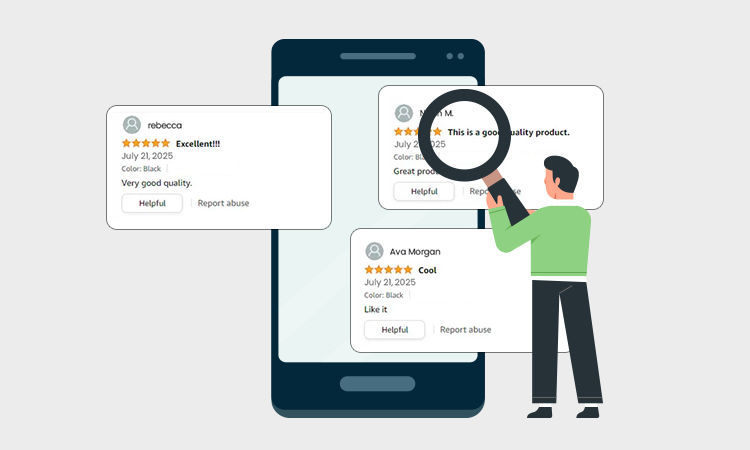
We have already talked about the signs that indicate a review is fake. You need to examine the review content first, as it will give you an idea of whether the review is fake or not.
Detecting the authenticity of review content is crucial, as 75% of consumers express their concerns about fake online product reviews. This statistic significantly indicates a growing awareness of the issue.
Content will reflect the originality of the reviews!
How to know you receive a new review on Amazon? Set up alerts for every review you receive on Amazon. If any reviews have multiple red flags or similar patterns that we mentioned above, they require proper investigation. You can categorize these Amazon reviews in simple spreadsheets to identify which one has these signs of fake Amazon reviews.
You can also use Amazon’s own notifications to be notified when your product receives a new review on that specific platform.
Without properly examining the review content, it is quite difficult to identify those fake review patterns and signs.
Some Examples of Fake Amazon Reviews
The following are some examples of fake reviews on Amazon. These examples will help you identify and understand fake reviews more clearly.
Generic or Vague Language:
‘Good product!’, ‘I love it.’, ‘Bad one’, or ‘Not good’
Excessive Praise:
‘The product is OUTSTANDING! It is beyond my expectations. I’ve never seen such a product. It’s perfect in every way. Five-star rating always!’
Vague Negativity:
‘The product didn’t work at all! Very bad product. Waste of money. The product is really terrible.’
Repetitive Words:
‘Great product! Good product! Highly recommended.’
Unusual Language:
‘The product is astounding. My experience with this product is transcendent. My life is forever changed after this purchase. I am deeply grateful!’
Comparison with Another Product/Brand:
‘The XYZ product from X brand is better than this product. The features of the XYZ product are quite good. That will be more value for money! I will not recommend. Please buy the XYZ product.’
Strategy 3: Investigate Reviewer’s Profile
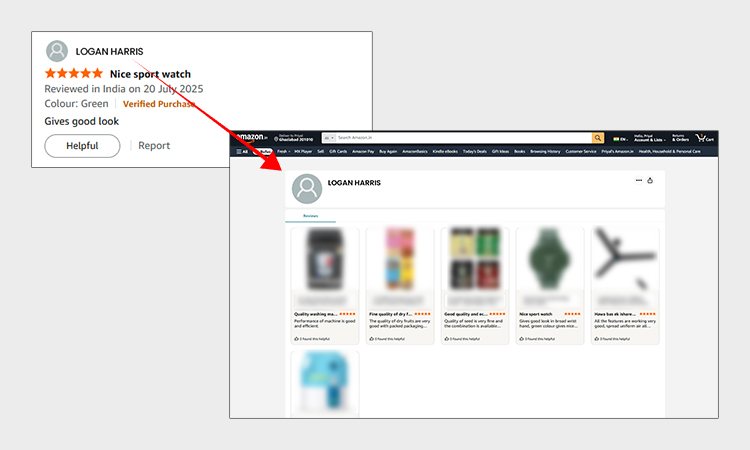
When you suspect an Amazon review to be fake after examining the pattern and content, the next thing you can do is to investigate the reviewer.
Fighting fake or spam reviews on your Amazon product listing page will be incomplete without learning more about the person who has shared that review. Click on the reviewer’s name and evaluate the profile to know more. Check the other reviews that person has shared so far.
What does Amazon allow you to check in the reviewer’s profile?
The platform allows you to check the name, other profile details, and even the other reviews. It lets you see how many reviews the person has shared till now, and which products they’ve reviewed so far.
The following are certain things that you must check when you investigate the reviewer’s profile.
- Profile creation date: It will help you identify new accounts with only a few reviews.
- Review history: You can identify a reviewer who only posts for products offered by specific brands.
- Profile picture: You must check whether the reviewer’s profile has a clear profile picture or not. The absence of a profile picture can be a sign of a fake review.
- Familiarity: You can identify trustworthy reviews if the reviewer’s name seems familiar to you or already have a history with them.
- Reviewer’s activity: Check if the reviewer has a history of sharing only positive or negative reviews or if he/she has shared reviews for a wide range of unrelated brands.
You need to find answers to these queries –
Is the reviewer you suspect a fraudster –
- Has a history of giving only the maximum ratings, such as ‘5-star or 1-star’, and nothing in between?
- Has reviewed many unrelated products on Amazon within a short period?
- Has shared very uniform or similar reviews, almost copy-pasted the texts?
- Has no verified purchases?
- Has obtained many ‘verified purchase’ tags through refunds?
If all the answers to these questions are ‘YES’ and the reviewer’s profile appears fishy, you can report those profiles via Seller Central.
You can copy the reviewer’s Amazon profile URL to provide it to Amazon Support. You may not remove such a fake Amazon review by yourself, but documenting these details will help the Amazon team’s investigation.
Strategy 4: Assess the Authenticity of ‘Verified Purchase’ Badge
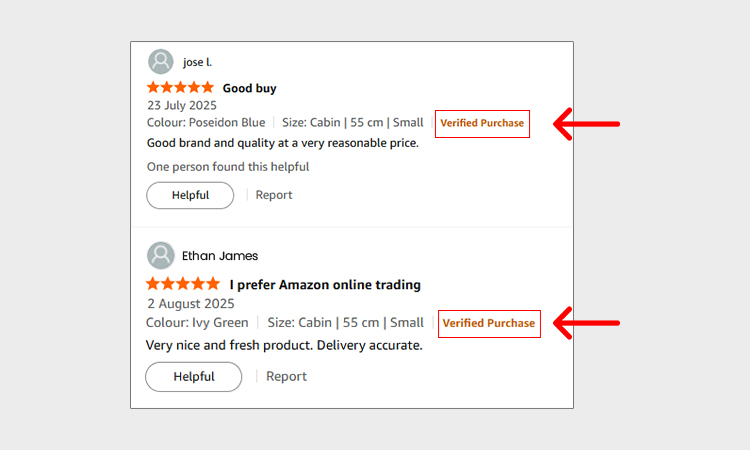
We’ve already talked about the ‘verified purchase’ badge that Amazon offers to those reviewers who share feedback about a product that they have actually bought.
It’s a significant symbol of a genuine reviewer!
However, it doesn’t guarantee the authenticity of a reviewer. Because some review scammers refund the purchases after getting the badge from Amazon. And there is also a concept called ‘review swapping’!
Likewise, many people can purchase a product and write negative reviews to get the ‘verified purchase’ badge. And then, they return the product. But multiple reviews (genuine ones) have more significance than this specific badge.
For instance, a single verified 5-star review with generic content can be fake, while a well-written, descriptive, but unverified review can be genuine (a person who has bought the same product from elsewhere).
What can you do?
You shouldn’t consider a review as fake just because it’s unverified. It could be legitimate feedback from a repeat customer! But always be cautious when you check patterns of unverified Amazon reviews. For the glowing reviews on your Amazon product listing page, you need to verify if any other products from different brands have received similar reviews on other independent sites.
Strategy 5: Employ Review-analyzing Tool

There are several tools that can help you analyze an Amazon review. Tools can make the process of identifying a fake review seamless!
According to a Wisernotify study, Amazon has a 43% fake review rate of the 33.5 million reviews on the bestselling products. You can imagine the urgency of checking the authenticity of these Amazon reviews.
Wondering which tool you can use to analyze Amazon reviews?
Here we’ll talk about the utilization of the top five review-analyzing tools. The details will help you choose a tool that specifically meets your requirements.
Note: The tools we’ve mentioned below are best for manual checks. If these tools raise a red flag for any review, you must follow up by assessing the review more closely. Don’t just blindly delete reviews; rather, use these tools to prioritize Amazon reviews that require more attention.
4 Best Tools to Identify Fake Amazon Reviews
Explore our list of the top 4 tools and check out which tool you can use to analyze Amazon reviews.
- ReviewMeta
It’s a free web tool that can analyze millions of reviews. This can help you determine which reviews you can trust and which you cannot. Additionally, it can help you identify potential review manipulation and provide a ‘trust score’ for every product it analyzes.
- Trustalyze
It’s a tool that can detect fake reviews and assess the trustworthiness of those. You can also examine whether a specific website is fake or genuine. This specific tool serves two functions.
- TheReviewIndex
This tool can detect fake reviews on Amazon and other e-commerce platforms as well. It offers you a summary after performing a sentiment analysis of products and customer feedback. The special feature of this tool is that it can provide you with insights into the authenticity of customer reviews.
- ReviewKick
Looking for a tool that can help brands effectively manage and improve their online reviews? ReviewKick is the tool that you can trust. This tool has the advanced features of identifying and addressing fake reviews.
4 Helpful Tips to Deal with Fake Reviews on Amazon
We hope that the above tips and tricks will help you find out the fake reviews in the sea of customer feedback on your Amazon product listing page.
But identifying those fraudulent reviews is not enough! You need to learn how you deal with those reviews and prevent them from damaging your genuine product rankings on Amazon. Learning these strategies will also help you protect your brand’s reputation on Amazon.
How Can Brands Deal with Fake Amazon Reviews?
There are many ways through which one can handle or respond to a fake review. It depends on why you want to respond – mainly the objective.
For example, you, as a seller on Amazon, want to boost your product rankings. But fake reviews are hampering your product’s reputation on such a leading e-commerce platform. So your objective is to protect your brand reputation and maintain your product’s higher ranking on Amazon.
This will determine how you’ll deal with the fake reviews.
Here we’ll explain some effective ways to handle fake reviews on Amazon without hampering your product’s rankings. Let’s get started.
Tip 1: Avoid Engaging in Fake Review Practices
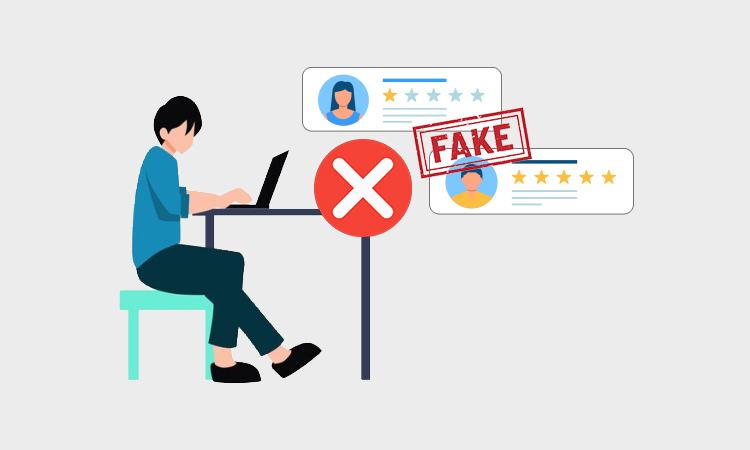
Struggling to get new customers on Amazon? Losing your product rankings? Are competitor products gaining more reviews on the platform?
It’s natural for brands to experience all these! But this doesn’t mean that you should engage in fake review generation.
Now the question comes – then what to do?
Firstly, you need to understand and adhere to Amazon’s policies that strictly prohibit fraudulent or manipulated reviews through any means. Take note of the things you must remember to avoid being involved in fake review practices.
- Never post any review for the products your brand offers. It might be considered as fake Amazon reviews! Let us tell you that this is a clear violation of Amazon’s review terms and policies.
- You shouldn’t offer any reward (e.g., incentives, discounts, gift cards, or money) to your customers or others to share positive reviews about your products.
- Using third-party services to generate reviews, as these services often employ fake accounts or manipulate reviews. It’s a clear violation of Amazon policies!
- Don’t pressure your customers to share positive reviews. If you bother your customers too many times to share their reviews, they may feel overwhelmed and choose not to purchase products from your brand. Requesting specific reviews is against Amazon’s policy.
- When you send review request emails to your customers, it should not contain any promotional content. You must focus on requesting genuine feedback, no matter whether it’s positive or negative.
- Don’t consider review swapping schemes or agree with your competitors to exchange positive reviews for each other’s products on Amazon.
- Always use Amazon-approved tools, such as the ‘Request a Review’ button, to send review requests. Don’t forget to follow Amazon’s guidelines on timing and content. You must contact the customer regarding review requests within 30 days of product order completion.
Tip 2: Report Fake Reviews on Amazon
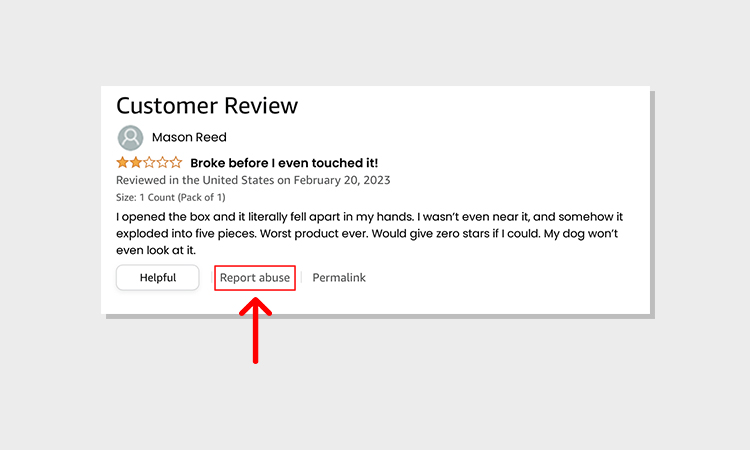
Negative or fake review management is a skill that you must have, as it will help you seamlessly handle unfavorable reviews without risking your product rankings and brand reputation on Amazon.
How to check fake reviews? You need to keep a regular track on your Amazon product listing for any new suspicious reviews with – unusual patterns, language, and reviewer profiles. If anything unusual is found, you need to report those reviews before any of your potential customers see it and perceive a negative narrative of your brand and products.
Bonus tip for you! You must always report fake reviews through Amazon’s official channels and provide supportive evidence to prove your claim.
Do you know that Amazon has a ‘zero-tolerance’ policy for fake reviews?
Any type of violation of their review guidelines can lead to the reviewer’s account suspension or removal. Even if Amazon finds that a seller is engaged in fraudulent review-generating practices, the platform can suspend the seller’s account as well.
In certain critical instances, Amazon can take legal actions against reviewers or brands who are involved in fake review schemes.
How to Report Fake Amazon Reviews?
It’s crucial to report fake reviews before they can damage your brand reputation on Amazon. When you want to manage online buyers reviews, identify fake reviews and report them based on which grounds the reviews have violated Amazon’s review policy.
Seems complex? We’re here to provide you with some easiest methods to report and remove fake reviews on Amazon.
- Use ‘Report Abuse’ Link – You can utilize this link, which you can find on your product page. You can click on it to flag a specific review for policy violation.
- Submit Your Seller Request – For more critical issues or systematic violations, you need to contact the team via Seller Support and your Seller Central account. You need to navigate to ‘Help’ and then ‘Contact Us’. After that, you need to choose ‘Report a Violation’ to submit your review report request.
- Be Specific about Amazon’s Policies – When reporting the review, you must be as specific as possible regarding why you want to report a review. Mention the seller’s name, store URL, and ASIN of affected products, and don’t forget to clearly explain the policy violation.
- Document Everything – If you decide to report a report, you must be ready with every supporting document that can prove your claim that the review is fake. Collect evidence like screenshots, order IDs, communication logs, and relevant receipts to support your claim.
- Follow-up – Amazon may take time to investigate and follow up on your report if you don’t see Amazon taking any action within a reasonable timeframe. You must ensure that your concerns are addressed.
Tip 3: Use Amazon Vine
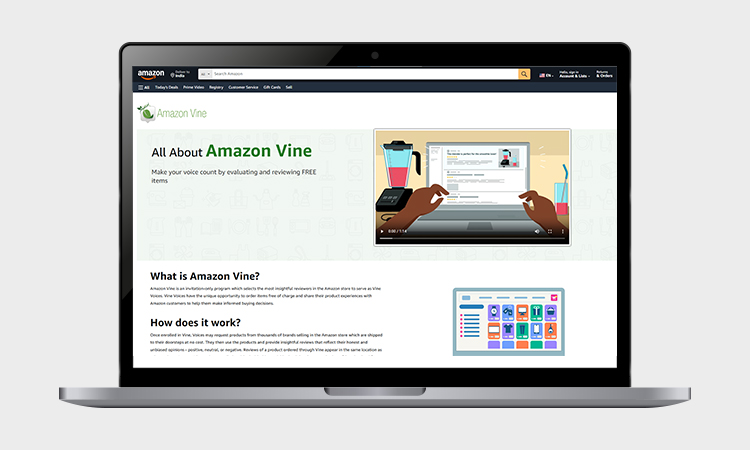
Did you know that Amazon has proactively blocked more than 275 million suspected fake reviews in 2023 and taken serious actions against thousands of reviewers who attempted to solicit fake reviews?
If your product listing page on Amazon has dozens of fake reviews, but you aren’t engaged in fake reviews, Amazon can suspend your brand. Thus, you can consider Amazon’s Vine Program!
What is the Vine Program? Amazon handpicks people as its ‘most insightful reviewers’ and allows them to request free products from thousands of brands in return for honest reviews.
Amazon’s Vine program encourages unbiased opinions (even if they are negative) of genuine customers who actually purchase a product before reviewing it on Amazon. Sellers who participate in this program are more likely to be extremely confident in their products.
Reviews are labeled as a part of the program and must be detailed, often with photos of the product. The Vine badge may signal higher trustworthiness than a regular review.
Some facts to remember if you want to participate in Amazon’s Vine Program –
- Vine reviewers often get free products from the brands, but they shouldn’t be paid money.
- As a seller, if you want to participate in your Vine program, you must tell Vine reviewers not to sell those free products or give them away to others.
- As a seller, you need to pay Amazon an enrollment fee for each product to participate in the Vine program.
Tip 4: Request Post-purchase Reviews
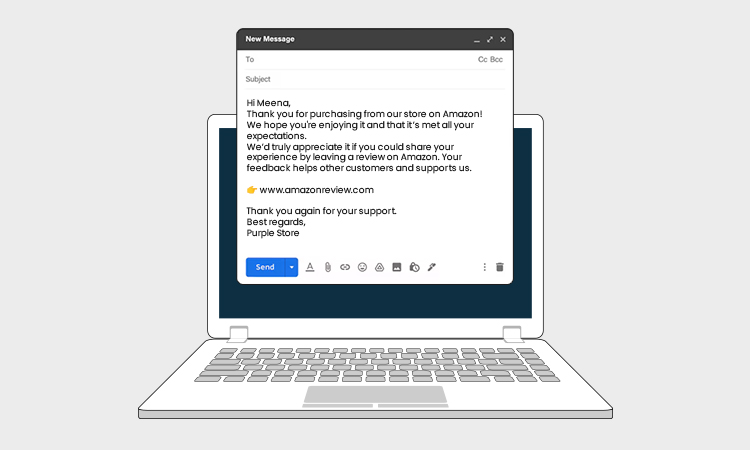
Someone has just purchased a product from your brand through Amazon?
It’s time to send the customer a review request to get their genuine feedback regarding his/her purchase request. If you don’t contact a customer within 30 days of their purchase, it is less likely to get a review.
Fact Check: Even if the reviews are negative, if they are genuine, they will add more value to your product listing page.
Yes, you heard it right! Nothing is more valuable than a genuine customer review. Effective customer review management strategies require you to encourage more positive, genuine reviews from your customers.
Now you must be wondering how you can ensure getting a review from your customers. Let’s have a look at our proven review request strategies.
- Email your customers – Send an email to your customers to request genuine reviews from them regarding their recent purchase from your brand.
- Ask them to leave an Amazon review – You must inform them to leave a review on your Amazon product listing page.
- Add the review page link – Additionally, you can also add a link to your Amazon product page in the email, so that the customers can seamlessly share their feedback on Amazon.
- Don’t ask for reviews directly – Never ask for reviews; request your customers to share their experience. Yes, when you showcase your curiosity to know your customers’ purchase requests from your brand, they will feel more valued and encouraged to share their feedback.
- Maintain a timeframe – A timeframe is crucial to request reviews. After a month, the review request may not seem as relevant as it will within the 30 days of purchase.
- Customize your request – Personalize your emails for each recipient. Never forget to mention their name, order ID, and the product they have purchased from your brand on Amazon.
- Always follow up – Haven’t received a review even after 15 days of sending the review request email? You must follow up with the customers and remind them about the review.
When your product listing page on Amazon is filled with genuine reviews from your customers, fake Amazon reviews cannot damage your product’s ranking or your brand reputation.
What Is Amazon Doing About Fake Reviews?
Amazon claims that it is constantly struggling with the increasing number of fake reviews on its platform. And the claim is not false!
You can just search ‘buy Amazon reviews’ on Google to see how many options are available online to buy fake Amazon reviews. Just imagine how tough the job is for the team to remove suspicious reviews from their platform.
The platform removes more likely fraudulent reviews and frequently restricts the sellers who are actively engaged in forbidden practices, such as –
- Actively engaging in generating fake reviews
- Offering gift cards or discount coupons in exchange for five-star reviews
- Employed bots to generate repetitive positive reviews to boost the review count
- Paying for positive reviews
Amazon claims to suspend or sometimes ban such sellers on its e-commerce platform. Those sellers can also face legal consequences in certain critical cases.
Did you know that Amazon banned almost 3,000 Chinese brands due to their involvement in fake review generation?
Even some famous brands were kicked off by Amazon because they had a significant number of fake reviews. But this raises a serious question – a product having fake reviews on Amazon doesn’t necessarily mean it’s a bad product!
Many brands that are new in the industry often generate fake reviews to gain an edge over their market competitors or to enhance their product’s online visibility. However, the Verified Purchase badge that Amazon provides to reviewers who buy a product.
We’ve already explained how sellers agree to review each other’s products on Amazon in exchange for positive reviews. This is a review swap scheme!
For all these, Amazon repeatedly emphasizes a ‘zero tolerance’ policy on review abuse.
- The company prohibits any kind of review manipulation, such as buying reviews, offering incentives, and engaging in review swap schemes.
- Amazon has employed sophisticated machine learning to examine review data for fraud.
- The algorithm blocks fake reviews on the platform by assessing review patterns like reviewer behavior, timing to detect authentic content, and account networks before the review goes live.
- The platform allows you to flag a fake review by clicking on the ‘Report Abuse’ button. It will inform the team that the review is fake and requires proper investigation.
- Sellers can use their account’s Seller Central to open cases related to suspicious reviews. They can provide order IDs and review links to the team of Amazon.
FAQs
Here are some frequently asked questions related to fraudulent Amazon reviews.
Many sellers on Amazon generate fake reviews to boost their product sales, employ bot-generated reviews, and even buy positive reviews. The competition in every sector is increasing rapidly. Brands want to gain a competitive edge over others. Due to all these factors, there is an increasing number of fake reviews on Amazon.
Yes, Amazon’s ‘Verified Purchase’ tag indicates a review is likely to be real. The tag signifies that the reviewer has bought the product from Amazon. However, this tag doesn’t guarantee that a review is 100% authentic. But the tag reduces the likelihood of fake reviews.
No, sellers cannot directly delete fake reviews from their Amazon listings. But they can report those fake reviews for violating the platform review policies. Amazon will examine the matter and decide whether those reviews should be removed or not. However, e-commerce platforms like Amazon have sophisticated machine learning systems that help them identify and remove fake reviews from their platform.
Yes, your competitors can buy fake negative reviews to post them on your Amazon listing and damage your brand reputation. They can also offer incentives to post negative reviews about your products available on Amazon and even post AI-generated negative reviews to hamper your product reputation on Amazon.
If you’re struggling to identify and handle fake reviews on Amazon and any other platform, you can seek professional help from a renowned online reputation monitoring agency. Sometimes, customer review management requires specific skills and knowledge.
If you don’t have an expert team to handle such critical issues, you can seek professional guidance. You can search for such an agency online and assess their offerings. You can either directly contact them via their provided contact details or fill out the contact form on their website.
Conclusion
Sellers on Amazon often lose their potential customers’ trust due to the presence of fake reviews on their product pages. On the other hand, many sellers who want to achieve a competitive edge over other sellers often engage in generating fake reviews. And of course, the intention is to boost their review count and improve their product rankings on Amazon.
But the negative part is – even the honest brands often suffer because of these fake Amazon reviews. But no need to worry! Our guide will surely help you seamlessly detect fake reviews on Amazon. We’ve also explained how you can effectively handle those reviews. We also recommend that you hire an online review management agency to seek their professional guidance.

